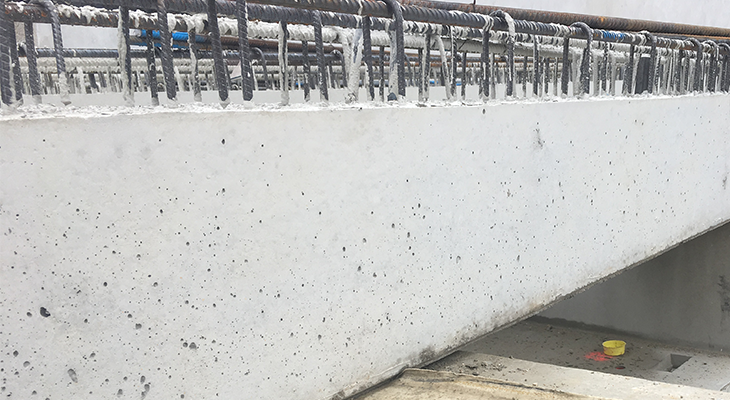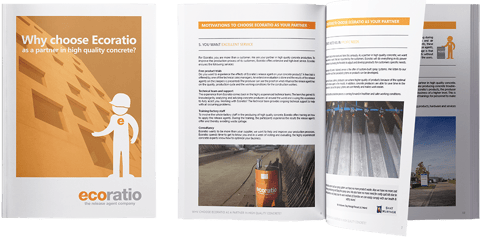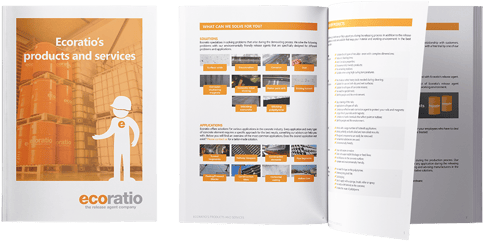
During the production process of concrete, several problems can occur– and you do not want that. As a concrete producer, you know that a smooth concrete surface without surface voids is desired. Unfortunately, this problem is one of the main issues in the precast concrete industries. Pinholes and air bubbles are described as surface voids, small holes that have an unfavorable effect on the concrete surface.
When the surface voids become too big, the concrete requires to have remedial work carried out on the surface to ensure compliance with the relevant specifications. This is waste of time, materials and money!
In this article I will discuss how to prevent surface voids by looking at the cause and giving tips that will help you achieve a better concrete surface.
What causes surface voids?
There are many variables that can affect the surface of your concrete. The most common causes for surface voids are entrapped air, the improper use of release agents or excess water within the concrete mix.
Air can create blowholes and air bubbles in the concrete when air becomes trapped within the concrete mix. Air does not mix with water and is not able to get out of the concrete mix, resulting in voids on your concrete surface.
Concrete release agents are also a cause for surface voids. When release agents are not applied correctly, the lower ends of the moulds may fill with puddles of oil or the release agent is not designed for the application. This causes holes on the surface of the concrete.
The same issue can occur when water is trapped in the moulds. Water can evaporate when the concrete mix cures, mostly caused by concretes with a higher water-cement ratio.
Or find another suitable eBook that suits your concrete problems
A smooth concrete surface
It is possible to fix those surface voids to get a smooth concrete surface finish, but this is costly, and we think it is better to prevent this problem. We want to assist you in this and we have listed some tips that can help you to get a smooth concrete surface. There are various variables that affect the surface finish, so keep in mind that the following tips that are given may not ensure the full elimination of surface voids.
Tip #1
Surface voids as pinholes and air bubbles are caused when air is entrapped during the curing of the concrete. Changes to the concrete mix design maybe required to ensure the correct viscosity for the application. The type of product/mould/compaction will have a direct impact on the mix viscosity required.
Tip #2
Increase the time that is spent on mixing the concrete. When the mixing time is extended, air and water break up in the process. As a result, the concrete mix will be more consistent.
Tip #3
Vibration of the concrete has influence on the elimination of surface voids. By vibrating the concrete either inside or outside of the mould, the vibration moves residual water and air to the surface of the concrete.
Tip #4
Use aggregate that does not have irregular pieces in your concrete mix. When the aggregate is more uniform, the concrete will become more fluid, so the chance that water and air can get trapped decreases.
Tip #5
Use the correct method of placement. Sometimes slowing the placement method can stop extra air being trapped into the concrete as the formwork is being filled. Some forms like columns may be better filled either by pumping from below or with the use of a tremie pipe. Sometimes filling a form too fast can also cause the concrete to segregate which can cause more surface voids.
Tip #6
Use the correct release agent for the removal of the concrete from the moulds. This needs to be applied in the correct manner, otherwise puddling will occur. These puddles can entrap air and water stopping them being removed by the vibration process.
The application of the release agent needs to be done very accurate and as thin as possible. Usually a thinner coating of release agent with ensure that air can easily migrate to along the formwork to the surface of the concrete. Thicker oils will sometimes cause air to become trapped against the concrete surface and the formwork causing surface voids.
More information about surface voids and other important problems during the concrete production can be found in our Quality guide. In this eBook we cover problems with solutions and how Ecoratio can assist you in improving the overall quality of your concrete finishes during the placement process.
Do you need other information?
Read one of our other eBooks about release agents and the quality of concrete elements:






